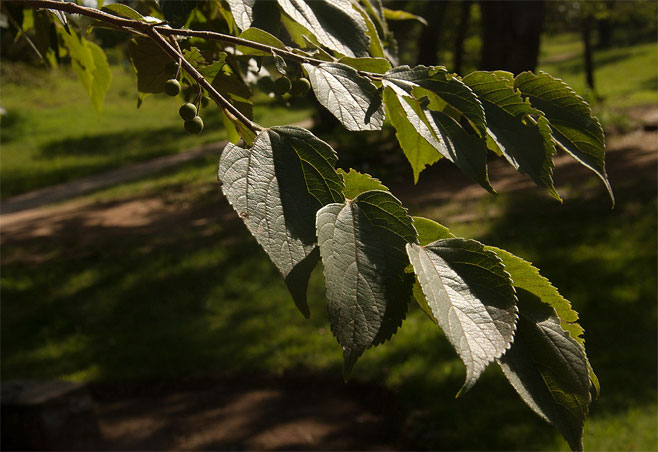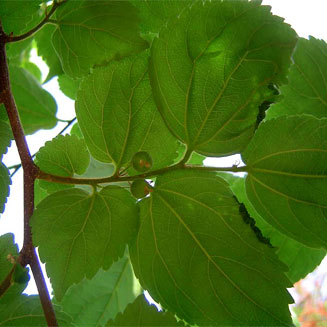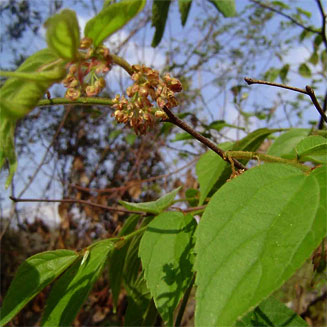Celtis africana (White stinkwood)
Witstinkhout [Afrikaans]; umVumvu [Xhosa];
umVumvu, inDwandwazane, uMoyawovungu ("stormy wind"), uSinga lwesalukazi
("old woman's sinew") [Zulu];
modutu, mohatlakgomo, lesika [South Sotho]; modutu [Tswana]; modutu,
mogatakgomo [North Sotho]; mpopano, mumvumvu [Venda]
Life
> eukaryotes >
Archaeoplastida >
Chloroplastida
>
Charophyta > Streptophytina > Plantae (land plants)
> Tracheophyta (vascular plants) > Euphyllophyta > Lignophyta (woody plants)
> Spermatophyta (seed plants) > Angiospermae (flowering
plants) > Eudicotyledons > Core Eudicots > Rosids >
Eurosid I > Order: Rosales
> Family: Cannabaceae > Genus:
Celtis
 |
|
Celtis africana, near curio shop, Great
Zimbabwe. [photo Bart Wursten ©, Flora of Zimbabwe] |
 |
 |
|
Celtis africana, Mukuvisi Woodland, office
area, Zimbabwe. [photo Bart Wursten ©, Flora of Zimbabwe] |
Celtis africana, Greystone Park Nature
Reserve, Zimbabwe. [photo Bart Wursten ©, Flora of Zimbabwe] |
Identification
See comparison of
native Celtis and Trema species. Celtis
africana is most easily confused with Trema orientalis
because they both have hairy, serrated leaves that are conspicuously
3-veined from the base and asymmetric at the base. However, they can
be easily distinguished by the fact that the serrations on the leaf
are only on the upper half of the leaf in Celtis africana
whereas they occur along the entire margin of the leaf in Trema
orientalis.
According to Palgrave & Palgrave (2002),
Celtis australis (from southern Europe and western Asia) and
Celtis sinensis (from China and Japan) are planted as
garden trees in southern Africa and are hybridising with Celtis
africana, with hybrids germinating freely, especially noticeable
in Gauteng. According to van Wyk & van Wyk (1997), Celtis
australis can be distinguished from Celtis africana by
having glossy green, hairless leaves, and Celtis sinensis by
having course-haired leaves with a more tapering tip and larger
marginal teeth.
Distribution and habitat
Widespread in South Africa and Zimbabwe except
for semi-arid and arid regions. Also found along south coast of
Mozambique. Grows in a wide range of habitats, including grassland,
bushveld, coastal dunes, river banks and dense forest.
Ecological interactions
- Fruit are eaten by:
- Seeds are eaten by:
- The tree is used as a nest site by:
Uses
- Planted as a shade tree in gardens and along avenues. For
instance they are planted along the length of St George's Mall
in Cape Town. They are used in this way because they are fast
growing and are deciduous so that in summer they provide shade
and in winter they let the sun through.
- The wood is not highly prized as it is tough and difficult
to work with. It is white to yellowish, sometimes tinged with
green and has a long grain and a woolly texture. It has been
used to a limited extent for items such as planks, yokes and
tent-bows but is not regarded as having any commercial value.
The wood has an unpleasant smell when cut, which is how the tree
got its name. It should not be confused with the true Stinkwood
Ocotea bullata,
which is not closely related to Celtis africana and which
yields commercially valuable timber.
- It is believed by some that the wood of this tree has power
over evil and that by driving wooden pegs of this species in the
ground, one is driving witches away (Palmer & Pitman 1972).
- In Botswana it is claimed that livestock will multiply if a
stick of this species is used for stirring meat that is cooking
(Palmer & Pitman 1972).
Links
References
- Palgrave, K.C. and Palgrave, M.C. 2002. Trees of Southern Africa. 3rd
Edition. Struik Publishers, Cape Town.
- Palmer, E. and Pitman, N. 1972. Trees of Southern Africa covering all
known indigenous species in the Republic of South Africa, South-West Africa,
Botswana, Lesotho and Swaziland. Volume 1. A.A. Balkema, Cape
Town.
- van Wyk, B. and van Wyk, P. 1997. Field Guide to Trees of Southern
Africa. Struik Publishers, Cape Town.
Text by Hamish Robertson |
